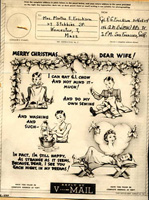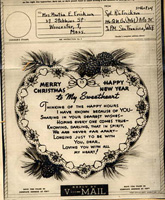
Introduction | Perception
of the Enemy | News of
the War | Keeping
in Contact | Re-entry
into the Community | Notes | Main
Index
Bridging the gap between soldiers and civilians was as important for those
abroad as it was for supporters at home during the war years. Numerous means
were used to help people keep in contact with loved ones kept distant by world
conflict, and a variety of different goals were achieved by these means. WWII
occurred well before the age of technology that we benefit from now. And while
we can keep in contact with loved ones world wide with the simple click of a
button, via email, fax, and telephone, long range communication during the early
1940s was for the most part limited to telegrams, pencils, and paper. Not surprisingly,
these options enjoyed unprecedented use during the WWII as people attempted
to remain close to loved ones far away (10).

V mail emerged during the war as a popular way for people at home to send words
of support, encouragement, and love to the troops. The notes were small, short
and sweet. Adorned with pictures and amusing pre-printed messages, they served
to boost morale in the harsh and hard- pressed military ranks. By the war's
close, over 1 billion V-mail letters had been sent abroad. The tiny but poignant
message cards became the precursor for our modern micro-film storage system
(11).
Photographs served as a way to keep many soldiers reminded of home. George
Lindberg mentioned the pictures he was conscientious enough to take of Quinsigamond
Village before leaving for duty. "To remind me of the village I took some
pictures of the village right before I left." (Berg)
He wanted to keep with him the memory of home as well as the memory of what
home was like pre-WWII as if keenly aware that things would never be the same
after such a world-altering event. Pictures also served to keep soldiers mindful
of all they had been through while abroad.
 Letter-writing
gained a whole new worth during the war and Americans spent a great deal of
time preparing hand-written notes. It was a therapeutic practice that also enabled
people to stay aware of the various details about loved ones' lives. As Grace
Butkus recalls, "I know my children wrote letters and ah, to their
Uncle Steve and their Uncle Jack, and they were so proud of them being in the
service that all they did was correspond with them, because they cherished the
letters that they got. And whatever was happening, they were very much interested."
(Butkus) Letters were used for vicarious
purposes and allowed civilians to stay aware to the efforts abroad and soldiers
to stay connected to the happenings of home.
Letter-writing
gained a whole new worth during the war and Americans spent a great deal of
time preparing hand-written notes. It was a therapeutic practice that also enabled
people to stay aware of the various details about loved ones' lives. As Grace
Butkus recalls, "I know my children wrote letters and ah, to their
Uncle Steve and their Uncle Jack, and they were so proud of them being in the
service that all they did was correspond with them, because they cherished the
letters that they got. And whatever was happening, they were very much interested."
(Butkus) Letters were used for vicarious
purposes and allowed civilians to stay aware to the efforts abroad and soldiers
to stay connected to the happenings of home.
For Herbert Berg, staying in contact occurred as much through mental contemplation as it did through writing letters. He sought connection not only with people back home but with those he fought against as well. When asked if he felt connected to his community at home while fighting the war abroad he responded,
"Oh yea, of course, when you're under combat.. The worst of that is flying through the anti-aircraft. Once the fighter planes come at you, you have something to do to occupy your time. You're just flying in on a target, and as the anti-aircraft get closer and closer, that seemed to be the worst part about flying through anti-air craft. And when the fighters come, as I said, you had something to occupy your time. You always think about the other fella out there. He probably didn't want to be out there any more than I did. There are a few human beings with twisted minds but most of us are not warriors at heart I don't believe," (Berg).
Berg sought to recognize the humanity in others even through the circumstance of war. It was in this ability to relate to others, the ability to connect on a broader level, that enabled him to stay grounded and experience comfort.